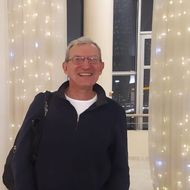Physicists from Russia and Brazil Unveil Mystery behind Complex Superconductor Patterns

The mechanism is described by the Ginzburg–Landau equation at the Bogomolny point
Scientists at HSE MIEM and MIPT have demonstrated that highly complex spatial structures, similar to the intricate patterns found in nature, can emerge in superconductors. Mathematically, these patterns are described using the Ginzburg–Landau equation at a specific combination of parameters known as the Bogomolny point. The paper has been published in the Journal of Physics: Condensed Matter.
One of the most intriguing and not fully understood questions in science is how seemingly simple natural laws give rise to complex patterns, such as zebra stripes or fish scales.
Scientists have long been trying to understand how such patterns emerge in nature. The first explanation was offered in 1952 by mathematician Alan Turing, one of the founders of computer science. According to Turing, complex patterns arise from the competition between simple interactions within a system. Thus, in chemical reactions, patterns are formed through two main mechanisms: diffusion (the distribution of substances) and autocatalysis (where the reaction accelerates itself). It soon became clear that while the Turing model can also describe the emergence of complex patterns in biology effectively, it does not account for all natural phenomena.
Scientists at HSE and MIPT, in collaboration with physicists at Universidade Federal de Pernambuco, Brazil, found that the formation of complex patterns in nature can also be explained using the Ginzburg–Landau equation that describes how the state of a superconductor changes in response to a magnetic field.
A superconductor is a material that conducts electric current without resistance, meaning there is no loss of electricity. Under the influence of a magnetic field, superconductors can exhibit different behaviours: they can either completely expel the magnetic field or allow it to penetrate their mass, forming spatial structures such as a lattice of vortices.
However, according to the theory of superconductivity, there exists a special combination of superconductor parameters—referred to as the Bogomolny point—where any structure can emerge. In this study, the scientists investigated how a magnetic field changes in response to external conditions near the Bogomolny point.

Co-author of the paper, Professor, MIEM HSE
An infinite variety of intricate configurations, like monsters, lie dormant at the Bogomolny point, waiting to be unleashed as you move away from it. Depending on how you move away from it, certain types of configurations emerge. There are various methods to move away: altering the temperature, adjusting the sample size, initiating an electric current, or stacking two superconductors atop each other. This will produce a vast array of exotic patterns.
For example, structures emerge in superconductors where regions devoid of a magnetic field coexist with regions where the magnetic field forms lattices of vortices. A superconducting film can give rise to extremely exotic patterns resembling the distribution of cases in the COVID-19 pandemic.
Co-author of the paper, Professor, MIEM HSE
Previously, superconductivity was not considered a phenomenon where complex patterns could occur, as a superconductor is a relatively simple physical system. However, it turns out that highly complex magnetic structures can indeed manifest in superconductors. Our research contributes to the current understanding of how complex patterns emerge in seemingly simple systems.
The scientists suggest that the effects observed in superconductors could be used in the development of measuring instruments. For instance, by monitoring changes in configurations within a superconductor, one can gauge the extent of temperature, current, or geometric alterations in the sample.
Vasily Stolyarov
Co-author of the paper, Director, Centre for Advanced Mesoscience and Nanotechnology, MIPT
Research in this field has been ongoing from both theoretical and experimental perspectives, as well as from a technological standpoint. Since 2018, we have been the pioneers in conducting and publishing a series of experimental studies that led to the discovery and description of the process of pattern formation on the mesoscopic scale in ferromagnetic superconductors. Now, we are actively searching for and devising new systems where superconducting patterns can be controlled, thus enabling their application in nanotechnology and nanodevices.
See also:
Scientists Clarify How the Brain Memorises and Recalls Information
An international team, including scientists from HSE University, has demonstrated for the first time that the anterior and posterior portions of the human hippocampus have distinct roles in associative memory. Using stereo-EEG recordings, the researchers found that the rostral (anterior) portion of the human hippocampus is activated during encoding and object recognition, while the caudal (posterior) portion is involved in associative recall, restoring connections between the object and its context. These findings contribute to our understanding of the structure of human memory and may inform clinical practice. A paper with the study findings has been published in Frontiers in Human Neuroscience.
Researchers Examine Student Care Culture in Small Russian Universities
Researchers from the HSE Institute of Education conducted a sociological study at four small, non-selective universities and revealed, based on 135 interviews, the dual nature of student care at such institutions: a combination of genuine support with continuous supervision, reminiscent of parental care. This study offers the first in-depth look at how formal and informal student care practices are intertwined in the post-Soviet educational context. The study has been published in the British Journal of Sociology of Education.
AI Can Predict Student Academic Performance Based on Social Media Subscriptions
A team of Russian researchers, including scientists from HSE University, used AI to analyse 4,500 students’ subscriptions to VK social media communities. The study found that algorithms can accurately identify both high-performing students and those struggling with their studies. The paper has been published in IEEE Access.
HSE Scientists: Social Cues in News Interfaces Build Online Trust
Researchers from the HSE Laboratory for Cognitive Psychology of Digital Interface Users have discovered how social cues in the design of news websites—such as reader comments, the number of reposts, or the author’s name—can help build user trust. An experiment with 137 volunteers showed that such interface elements make a website appear more trustworthy and persuasive to users, with the strongest cue being links to the media’s social networks. The study's findings have been published in Human-Computer Interaction.
Immune System Error: How Antibodies in Multiple Sclerosis Mistake Their Targets
Researchers at HSE University and the Institute of Bioorganic Chemistry of the Russian Academy of Sciences (IBCh RAS) have studied how the immune system functions in multiple sclerosis (MS), a disease in which the body's own antibodies attack its nerve fibres. By comparing blood samples from MS patients and healthy individuals, scientists have discovered that the immune system in MS patients can mistake viral proteins for those of nerve cells. Several key proteins have also been identified that could serve as new biomarkers for the disease and aid in its diagnosis. The study has been published in Frontiers in Immunology. The research was conducted with support from the Russian Science Foundation.
Scientists Develop Effective Microlasers as Small as a Speck of Dust
Researchers at HSE University–St Petersburg have discovered a way to create effective microlasers with diameters as small as 5 to 8 micrometres. They operate at room temperature, require no cooling, and can be integrated into microchips. The scientists relied on the whispering gallery effect to trap light and used buffer layers to reduce energy leakage and stress. This approach holds promise for integrating lasers into microchips, sensors, and quantum technologies. The study has been published in Technical Physics Letters.
HSE Scientists Test New Method to Investigate Mechanisms of New Word Acquisition
Researchers at the HSE Centre for Language and Brain were among the first to use transcranial alternating current stimulation to investigate whether it can influence the acquisition of new words. Although the authors of the experiment have not yet found a link between brain stimulation and word acquisition, they believe that adjusting the stimulation parameters may yield different results in the future. The study has been published in Language, Cognition and Neuroscience.
Twenty vs Ten: HSE Researcher Examines Origins of Numeral System in Lezgic Languages
It is commonly believed that the Lezgic languages spoken in Dagestan and Azerbaijan originally used a vigesimal numeral system, with the decimal system emerging later. However, a recent analysis of numerals in various dialects, conducted by linguist Maksim Melenchenko from HSE University, suggests that the opposite may be true: the decimal system was used originally, with the vigesimal system developing later. The study has been published in Folia Linguistica.
Scientists Rank Russian Regions by Climate Risk Levels
Researchers from HSE University and the Russian Academy of Sciences have assessed the levels of climate risks across Russian regions. Using five key climate risks—heatwaves, water stress, wildfires, extreme precipitation, and permafrost degradation—the scientists ranked the country’s regions according to their need for adaptation to climate change. Krasnoyarsk Krai, Irkutsk Region, and Sverdlovsk Region rank among the highest for four of the five climate risks considered. The study has been published in Science of the Total Environment.
HSE Researchers Teach Neural Network to Distinguish Origins from Genetically Similar Populations
Researchers from the AI and Digital Science Institute, HSE Faculty of Computer Science, have proposed a new approach based on advanced machine learning techniques to determine a person’s genetic origin with high accuracy. This method uses graph neural networks, which make it possible to distinguish even very closely related populations.


